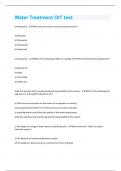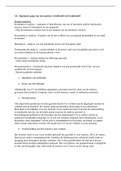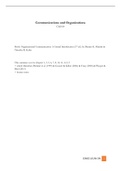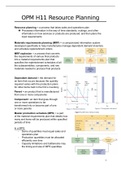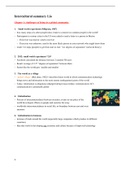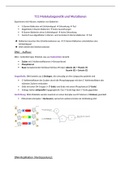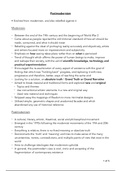Topic 1.1 Introduction
Reading 1
Data (D) is the basis of everything. On top of it we build Information (I), on top of that
Knowledge (K) and at the very top we build Wisdom (W). The pyramid also gives the
impression that the higher we get, the lower the volume is, which is easy to believe. How
exactly we are supposed to base each level on the next lower one is not shown. Also, the
impression of clear dividing lines between the level is quite misleading. All in all, the pyramid
is best seen as a nice metaphor to start from, flawed as all metaphors are as soon as a
certain level of detail is reached.
- Numbers
- Symbols
- Text
- Images
- Sound recording
- Video
In themselves meaningless, but they might derive meaning from their context and somebody
must have thought they were useful, as they are stored.
,Data is at the basis, now at the left, but here it is taken to be clearly separate from the later
nodes. There is a vast reservoir of it, which is somewhere outside of us and from which we
take whatever can be used whenever we think it is useful. On the far right we find Wisdom,
also separated. The reason of the separation now is that Wisdom is on a different dimension
than the others, less concerned with knowing things, but rather with applying our
knowledge in a proper way. In the middle we find Information and Knowledge, as expected,
but Knowledge has been split into Knowledge (= knowledge about things and how to do
things) and Understanding (= knowledge about the reasons of things). In the text below, we
will not adopt this separation. Two more components are added, contributing to Knowledge
(which by the way we interpret here in another way than the composer of the figure). The
reason for more contributors is that often Information alone is insufficient to derive
Knowledge from it, but we can call on other resources. Experience helps us gather the
Knowledge we need by relating what we think we know to the world around us (we are
“grounding” our information). Where Experience is personal, Teaching is social. People help
each other in gathering Knowledge by providing some of their Knowledge which they think
others want or should have. All in all, this visualization adds some valuable insights, but it
also lacks an equally important one: all those arrows are not just one-way. "Higher" levels
contribute to "lower" levels, either directly or through Teaching or even Data storage.
Data = the fundamental building blocks of what you can know.
Data are meaningless, a number cannot be interpreted without knowing their context, e.g. a
location or time.
Information = selected and possibly processed bits of data which together represent
something that you want to know. The processing might be necessary to get the data into a
form in which we can use it as we want.
Information is data that reduce uncertainty!
Information = something you want to know = a selection of data that is somehow useful for
you, processed so that it can be used as desired.
Most data is in existence not information to us!
Knowledge = what you know, integrated into a larger whole (= your model of the world).
- As integrated into a larger whole
- The integration has been happening over time
- The individual components may not be accessible any more
You probably know by heart how to get from home to work, but it is unlikely that you can
describe all the bits of information that you collected to get this knowledge. And you know
how to speak your mother tongue without remembering when you learned specific words.
Knowledge is fundamentally personal, but may be shared with social contacts/specific
groups. However, full sharing is not easy.
“I am trying to teach you what I know about information”
Communication = an attempt to transfer knowledge = a process in which a sender transfers
data to a receiver.
In the hope that the receiver will perceive these data to be information and integrate this
into their knowledge.
The success is dependent on the receiver and situation:
, - A willing receiver will cooperate freely
- An unwilling/unknowing receiver may need more work
- A specific receiver is also easier than a general one (mass communication)
If we visualize the gathering of knowledge in a context with one-way arrows from data
through information to knowledge, what are we ignoring?
Personally That our existing knowledge can help in this process.
Socially That we also learn by being taught, which originates in someone’s knowledge.
Reading 2
Communication = a process in which a ‘sender’ transfers a ‘message’ to a ‘receiver’.
Knowledge itself cannot be transferred, only data! A message therefore consists of some
form of data transfer, e.g. a one-dimensional stream of speech or a multi-dimensional and
even multi-modal website.
In order for the ‘knowledge transfer’ to succeed, the data transfer has to be carefully built
from selected bits of information in a sensible order and represented optimally by the right
data representations.
Obviously, how messages should be composed also depends in other ways on the
communicative situation. In a face-to-face human conversation, the receiver can indicate
understanding by giving signals ("backchannels"), showing understanding by repeating parts
of the message as they were understood, or on the other asking for clarification when
needed. Furthermore, it is likely that the roles of sender and receiver shift between the two
(or more) participants during the conversation. In distanced communication, such as letters,
the same is possible but at a much slower rate, so that the sender has to work harder at
making themselves clear right away. In mass communication, most of the receivers will
, never respond, so that the message has to be composed as completely understandable in
the first attempt.
The goal of communication is the transfer of Information.
The practical form of communication forces that the transfer is forced to be in quantities of
Data.
The role of Information in Communication is… The sender selects the information and the
receiver integrates it in their knowledge.
The dimensionality of a message in communication is not restricted in principle, but human
senders and receivers tend not to go beyond 4 dimensions.
Topic 1.2 Grice
Paul Grice’s notion of the Cooperative Principle Communication is a social interaction in
which both participants want to succeed.
Unfortunately, the interaction is quite complicated as the sender is trying to provide
knowledge but is restricted to presenting data.
The knowledge has to be presented in small enough bits for the receiver to handle!
Furthermore, the receiver should be giving signals that the previous bits are indeed received
intact or that some clarification is needed.
When Grice formulated his maxims, he intended to describe how people normally behave in
conversation.
Grice’s Maxims primarily describe the communicative action of the sender.
Grice’s Maxims can aid the communicative action of the receiver.
Grice’s Maxims are being followed in normal conversation NOT in all cultures in the world.
Conversational implicature
In normal conversation, people expect others to follow these maxims
- Allowing for imperfect ability in normal circumstances
- And for purposefully breaking them in special situations
Flouting Grice’s Maxims = not following the maxims, but expecting the receiver to notice and
change the understanding.
If the receiver notices the sender flouting, this should be interpreted as a signal that the
message carries more than surface meaning, which can be interpreted by assuming that the
maxims are followed on some deeper level.
Violating Grice’s Maxims = not following the maxims, expecting the receiver not to notice
and hence to be misled.
Maxim of quality: “Just coming to the lectures will be enough to pass the exam”
Maxim of quantity: “There is a mature oceanic whitetip shark in the sea with you, that looks
as if it is swimming in your direction”
Maxim of relevance: “How many died in the place crash? I was visiting my grandmother
when I heard the news”
Maxim of manner: “Be perspicuous”
Maxim of quality: “If you do the course work, you are guaranteed to pass the exam”
Maxim of quantity: “There is a big fish swimming towards you”
Maxim of relevance: “How many died in the plane crash? No Americans were abourd”
Reading 1
Data (D) is the basis of everything. On top of it we build Information (I), on top of that
Knowledge (K) and at the very top we build Wisdom (W). The pyramid also gives the
impression that the higher we get, the lower the volume is, which is easy to believe. How
exactly we are supposed to base each level on the next lower one is not shown. Also, the
impression of clear dividing lines between the level is quite misleading. All in all, the pyramid
is best seen as a nice metaphor to start from, flawed as all metaphors are as soon as a
certain level of detail is reached.
- Numbers
- Symbols
- Text
- Images
- Sound recording
- Video
In themselves meaningless, but they might derive meaning from their context and somebody
must have thought they were useful, as they are stored.
,Data is at the basis, now at the left, but here it is taken to be clearly separate from the later
nodes. There is a vast reservoir of it, which is somewhere outside of us and from which we
take whatever can be used whenever we think it is useful. On the far right we find Wisdom,
also separated. The reason of the separation now is that Wisdom is on a different dimension
than the others, less concerned with knowing things, but rather with applying our
knowledge in a proper way. In the middle we find Information and Knowledge, as expected,
but Knowledge has been split into Knowledge (= knowledge about things and how to do
things) and Understanding (= knowledge about the reasons of things). In the text below, we
will not adopt this separation. Two more components are added, contributing to Knowledge
(which by the way we interpret here in another way than the composer of the figure). The
reason for more contributors is that often Information alone is insufficient to derive
Knowledge from it, but we can call on other resources. Experience helps us gather the
Knowledge we need by relating what we think we know to the world around us (we are
“grounding” our information). Where Experience is personal, Teaching is social. People help
each other in gathering Knowledge by providing some of their Knowledge which they think
others want or should have. All in all, this visualization adds some valuable insights, but it
also lacks an equally important one: all those arrows are not just one-way. "Higher" levels
contribute to "lower" levels, either directly or through Teaching or even Data storage.
Data = the fundamental building blocks of what you can know.
Data are meaningless, a number cannot be interpreted without knowing their context, e.g. a
location or time.
Information = selected and possibly processed bits of data which together represent
something that you want to know. The processing might be necessary to get the data into a
form in which we can use it as we want.
Information is data that reduce uncertainty!
Information = something you want to know = a selection of data that is somehow useful for
you, processed so that it can be used as desired.
Most data is in existence not information to us!
Knowledge = what you know, integrated into a larger whole (= your model of the world).
- As integrated into a larger whole
- The integration has been happening over time
- The individual components may not be accessible any more
You probably know by heart how to get from home to work, but it is unlikely that you can
describe all the bits of information that you collected to get this knowledge. And you know
how to speak your mother tongue without remembering when you learned specific words.
Knowledge is fundamentally personal, but may be shared with social contacts/specific
groups. However, full sharing is not easy.
“I am trying to teach you what I know about information”
Communication = an attempt to transfer knowledge = a process in which a sender transfers
data to a receiver.
In the hope that the receiver will perceive these data to be information and integrate this
into their knowledge.
The success is dependent on the receiver and situation:
, - A willing receiver will cooperate freely
- An unwilling/unknowing receiver may need more work
- A specific receiver is also easier than a general one (mass communication)
If we visualize the gathering of knowledge in a context with one-way arrows from data
through information to knowledge, what are we ignoring?
Personally That our existing knowledge can help in this process.
Socially That we also learn by being taught, which originates in someone’s knowledge.
Reading 2
Communication = a process in which a ‘sender’ transfers a ‘message’ to a ‘receiver’.
Knowledge itself cannot be transferred, only data! A message therefore consists of some
form of data transfer, e.g. a one-dimensional stream of speech or a multi-dimensional and
even multi-modal website.
In order for the ‘knowledge transfer’ to succeed, the data transfer has to be carefully built
from selected bits of information in a sensible order and represented optimally by the right
data representations.
Obviously, how messages should be composed also depends in other ways on the
communicative situation. In a face-to-face human conversation, the receiver can indicate
understanding by giving signals ("backchannels"), showing understanding by repeating parts
of the message as they were understood, or on the other asking for clarification when
needed. Furthermore, it is likely that the roles of sender and receiver shift between the two
(or more) participants during the conversation. In distanced communication, such as letters,
the same is possible but at a much slower rate, so that the sender has to work harder at
making themselves clear right away. In mass communication, most of the receivers will
, never respond, so that the message has to be composed as completely understandable in
the first attempt.
The goal of communication is the transfer of Information.
The practical form of communication forces that the transfer is forced to be in quantities of
Data.
The role of Information in Communication is… The sender selects the information and the
receiver integrates it in their knowledge.
The dimensionality of a message in communication is not restricted in principle, but human
senders and receivers tend not to go beyond 4 dimensions.
Topic 1.2 Grice
Paul Grice’s notion of the Cooperative Principle Communication is a social interaction in
which both participants want to succeed.
Unfortunately, the interaction is quite complicated as the sender is trying to provide
knowledge but is restricted to presenting data.
The knowledge has to be presented in small enough bits for the receiver to handle!
Furthermore, the receiver should be giving signals that the previous bits are indeed received
intact or that some clarification is needed.
When Grice formulated his maxims, he intended to describe how people normally behave in
conversation.
Grice’s Maxims primarily describe the communicative action of the sender.
Grice’s Maxims can aid the communicative action of the receiver.
Grice’s Maxims are being followed in normal conversation NOT in all cultures in the world.
Conversational implicature
In normal conversation, people expect others to follow these maxims
- Allowing for imperfect ability in normal circumstances
- And for purposefully breaking them in special situations
Flouting Grice’s Maxims = not following the maxims, but expecting the receiver to notice and
change the understanding.
If the receiver notices the sender flouting, this should be interpreted as a signal that the
message carries more than surface meaning, which can be interpreted by assuming that the
maxims are followed on some deeper level.
Violating Grice’s Maxims = not following the maxims, expecting the receiver not to notice
and hence to be misled.
Maxim of quality: “Just coming to the lectures will be enough to pass the exam”
Maxim of quantity: “There is a mature oceanic whitetip shark in the sea with you, that looks
as if it is swimming in your direction”
Maxim of relevance: “How many died in the place crash? I was visiting my grandmother
when I heard the news”
Maxim of manner: “Be perspicuous”
Maxim of quality: “If you do the course work, you are guaranteed to pass the exam”
Maxim of quantity: “There is a big fish swimming towards you”
Maxim of relevance: “How many died in the plane crash? No Americans were abourd”


